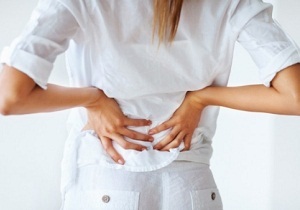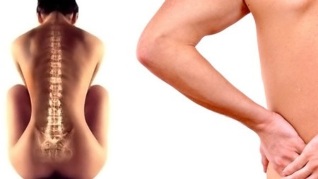According to statistics, 70-80% of our country's population at least once in my life encountered back pain in the lower back, or medically, pain in the lower back. Its incidence in the UK is 59 per cent in Denmark and 70% in Finland, 75%. All granted "sick leave" our country's third cases of back pain.

Causes of lower back pain can be very different — from the psychogenic factors of metastasis of cancer. Fortunately, serious pathology, not more than 5% of cases pain in the lower back, its main cause is overexertion or muscle cramps and other problems of the musculoskeletal system.
The type of back pain in the lumbar region
Back pain, like any other organ, are different. Most often it is the nature of the pain is the first sign that the doctor can make the assumption that the nature of the disease.
The origin of back pain can be:
- primary — caused by chronic functional or degenerative changes in the tissues of the spine and muscles, sometimes with involvement of adjacent structures — the spinal nerve roots.
- secondary — caused by trauma, infection, arthritis or osteoarthritis of the intervertebral joints, damage to internal organs.
The duration of pain may be:
- acute — caused by a new injury or a newly emerging pathological condition, inseparably connected with it, take up to 6 weeks;
- subacute — lasts 6-12 weeks;
- chronic — lasting more than 12 weeks.
Typical clinical symptoms depending on the cause of the pain.
Muscular-tonic and other pain syndromes
Hypothermia, constant uncomfortable posture during work or rest, improper movement patterns, degenerative diseases of the spine, changing the height and elasticity of intervertebral discs, which leads to the fact that muscle load is distributed unevenly. Some of them are becoming increasingly congested, which, on the contrary, do not get the required load. As a result, the individual muscle begins to spasm, which causes pain. There are so-called. trigger points, effect, which increases the spasm and pain. The characteristic features of the pain:
- clearly limited area (local pain);
- is felt deep in the muscle layer;
- muscle feel tight tight area or a block, inside which is found a particularly painful spot;
- when exposed to these points the pain increases sharply, causing the patient to shiver (a symptom of the jump);
- restriction;
- if you can stretch the muscle pain will be reduced.
It is such a pain - are creams that are warm or popular devices. However, their effect is short, after all, the reason that causes a muscle spasm, they do not solve. More reliable method — the injection of pain medication directly into the trigger point, as well as kinesio therapy, physiotherapy, manual therapy.
Compressive radiculopathy
Caused by compression or stretching of the spinal nerve roots due to disc herniation, or reduce its height and, as a consequence, the distance between the vertebrae. This pain often feels shallow, extending rather in the skin than in the deep tissues. It sharply increased to sneezing, cough, strain on the spine. It is this pain feels like the classic "cross" radiating along the nerve root.
Spinal stenosis
Caused due to disc herniation, protrusion (bulging) of part of the spinal canal or the appearance of sequestration — a separate part of the disk. In any case packaged entity called "ponytail" — the roots of lowest spinal nerves innervate the lower extremities. The pain extends along the course of nerve roots in the waist of the foot, and there alone, and walking, increases with extension of the spine and decreases when tilted forward.
Special syndrome
Due to pathology of the small intervertebral (facet) joints. The pain may be local, but also the radiation (let) in the groin, tailbone, back of the thigh. Is worse when bending and twisting at the waist.
All of these types of pain syndrome occur acutely, sometimes the patient can even tell what day after exposure (something lifted up, not to turn, etc.). The pain gets worse towards the evening and after exercise, reduce the after the holidays. Often such pain is typical for people in middle and old age.

Inflammatory pain
Caused by inflammatory lesions of the spine in the joints — different types of arthritis: rheumatoid arthritis, Reiter's disease, ankylosing spondylitis, etc., Inflammatory pain often occurs in relatively young people, develops gradually. It is the largest of the afternoon and drops in the evening or after physical exertion. Often accompanied by morning stiffness.
Other possible causes of lower back pain — a pathology of internal organs, for example kidney disease, or inflammation of the appendages in women. Because many conditions can occur in the same way, at least in terms of pain, it is better not to do the diagnostics yourself, and consult a doctor.
Immediate specialist consultation is necessary if:
- the pain came after the injury, especially in women over the age;
- in the history of the cancer;
- the pain is accompanied by temperature rise;
- suddenly and without apparent reason to lose weight;
- walking changes or reduced legs;
- have difficulty in urination and defecation.
These signs can be symptoms of serious diseases that require immediate treatment.
Diagnostic pathology
Pain in the back and lumbar region doctor first just to rule out life-threatening condition — fortunately they are quite rare.
General and biochemical blood analysis allows to reveal the inflammatory changes, to detect elevated levels of calcium, characterized by the metastasis of malignant tumors of bone structures, changes in the blood cells of multiple myeloma and so on. Men can hand over the analysis of prostate specific antigen rule out possible prostate cancer.
X-ray examination reveals that the change in height of the intervertebral discs, osteophytes possible in — growth of bone tissue, which is caused by a wrong sharing of the load on the spine, changing the shape as well as the vertebrae themselves.
CT and MRI show bulging of the intervertebral disc, calcification (areas of calcification), spinal stenosis.
Today these two studies is gradually becoming an ultrasound of the spine to detect similar changes, without exposing the patient to excessive radiation load.
Mandatory consultation of the neurologist, according to testimony — chiropractor.
After a complete research, it is clear, the treatment strategy. As a rule, to cope with the pain in the lumbar potential therapeutic methods, surgery is indicated is relatively rare.
Medication pain lumbar back
In 95% of cases the patient does not have to worry about — usually back pain is not a threat to health and can be curable. Myofascial syndrome is provided faster to remove radicular pain may require several months. However, in most cases it is necessary medical treatment. The use of non-steroidal anti-inflammatory drugs (Nsaids), which relieve pain and reduce swelling, drugs to maintain the intervertebral cartilage. Sometimes reduce pain and swelling, and it is prescribed hormonal medications — they work faster than non-steroidal anti-inflammatory, they are administered in the form of closures and droppers under the supervision of a doctor.
Drugs can be in the form of ointments and gels — this method treats back pain popular in commercials. But because of the method of the introduction into the organism of the active substance, the use of external means is the most inefficient, it is possible to predict, because most of the funds did not even penetrate through the skin.
Another popular method is oral medication, or, more simply, pills and capsules. Taking a pill is easy, the effect occurs quite quickly, usually a half hour-hour, but long-term use of medication can affect the gastrointestinal tract.
Therefore the fastest and most effective way to relieve the pain of injections directly into the muscle or area of the affected nerve root, the so-called blockade. Their only drawback is the strict requirement of high qualification of the doctor who performed this manipulation.
Non-drug treatment
Typically, medical therapy is non-drug methods. What physical therapy is necessary, will solve the doctor. This can be a classic massage or chiropractic, osteopathic care and acupuncture. Popularity and physical therapy — specific exercises in the form of class a special demolition devices, which help to relieve tense muscles, formation of new business models, thereby removing the cause of back pain.

So, the best option for treatment of back pain — a combination of medical methods and non-pharmacological approach. Such a complex work in several directions allows faster to cope with the disease, get rid of the pain or to get a lasting effect.

























